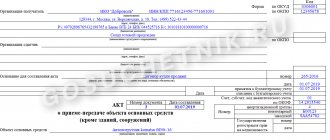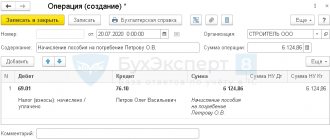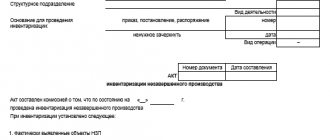Accounting consequences of writing off work in progress
We prepare documents
For various reasons, the company may change its plans, and it will have to liquidate the unfinished fixed asset. Moreover, this object can be written off only if there are documents confirming the very fact of its liquidation.
If construction as such has not yet begun, but, for example, money has already been spent on design work, then these capital investments are also considered unfinished. After all, such costs participate in the formation of the initial cost of the object and cannot be written off as expenses in the period in which they were incurred
The liquidation of unfinished work begins with management making an appropriate decision, for which an order is issued. The order needs:
- indicate the reason for making such a decision;
- appoint a commission to prepare documentation and determine suitable materials remaining after liquidation
Upon completion of all liquidation work (including dismantling/dismantling), the commission issues an act of decommissioning of the unfinished construction project. The act is drawn up in any form, taking into account the requirements for primary documents. Moreover, its form must be approved by order of the manager. The act can be drawn up, for example, like this.
Act on write-off of unfinished construction object No. 1
October 31, 2021
In accordance with Order No. 68 dated July 29, 2021, the liquidation of the unfinished construction facility “Industrial Building No. 3” was carried out:
| Types and stages of work that form the cost of an unfinished construction project | Method of work execution | Cost of work performed as of the date of liquidation according to accounting data, excluding VAT, rub. | VAT on contract work, rub. | Date of acceptance for accounting of completed work | When carrying out construction work by contract method | |
| Agreement | Contractor information | |||||
| Design and survey work | Contracting | 560 000,00 | 100 800,00 | 14.05.2015 | from 02/16/2015 | LLC "Proektservis" |
| Foundation structure | Contracting | 2 680 000,00 | 482 400,00 | 05.10.2015 | No. 18 from 06/05/2015 | LLC "Stroykomplekt" |
| Assembly of metal structures | Contracting | 1 110 000,00 | 199 800,00 | 23.10.2015 | No. 18 from 06/05/2015 | LLC "Stroykomplekt" |
| Total: | 4 350 000,00 | 783 000,00 | ||||
Information on costs associated with the liquidation of an unfinished construction project:
| Type of work | Document, number, date | Cost without VAT, rub. | VAT, rub. |
| Dismantling of metal structures | Certificate of completed work of Stroykomplekt LLC No. 15 dated 08/30/2016 | 78 000,00 | 14 040,00 |
| Analysis of the foundation, backfilling the pit | Certificate of completed work of Stroykomplekt LLC No. 44 dated 10/28/2016 | 120 000,00 | 21 600,00 |
| Total: | 198 000,00 | 35 640,00 |
Information on the receipt of material assets from the liquidation of an unfinished construction project subject to capitalization:
| Name | Unit | Quantity | Cost without VAT, rub. | |
| units | Total | |||
| Scrap metal | Kg | 2300 | 28,00 | 64 400,00 |
| Total: | 64 400,00 | |||
The date of writing off the construction-in-progress object from accounting is 10/31/2016.
Reflected in accounting
Make the following entries in accounting:
| Contents of operation | Dt | CT | Amount, rub. |
| As of the date of the work completion certificate | |||
| The costs of dismantling metal structures were written off | "Other expenses" | 60 “Settlements with suppliers and contractors” | 78 000,00 |
| VAT on dismantling work is included | 19 “VAT on purchased assets” | 60 “Settlements with suppliers and contractors” | 14 040,00 |
| The costs of dismantling the foundation were written off | "Other expenses" | 60 “Settlements with suppliers and contractors” | 120 000,00 |
| VAT on dismantling the foundation is taken into account | 19 “VAT on purchased assets” | 60 “Settlements with suppliers and contractors” | 21 600,00 |
| VAT claimed by the contractor is recognized as another expense | "Other expenses" | 19 “VAT on purchased assets” | 35 640,00 |
| As of the date of write-off of the unfinished construction project according to the act | |||
| The cost of an unfinished construction project has been written off | "Other expenses" | 08 “Investments in non-current assets” | 4 350 000,00 |
| Scrap metal accepted for registration | 10 “Materials”, subaccount “Other materials” | "Other income" | 64 400,00 |
| Materials received upon disposal of property are accounted for at the current market value on the date of their acceptance for accounting. Current market value refers to the amount that can be received upon the sale of an asset. In this case, data on the current price must be documented. To do this, you can use prices from the price lists of organizations involved in the collection of scrap metal | |||
CONCLUSION
The cost of work in progress is recognized as part of other expenses on the date of drawing up the act of writing off this object after completion of all work.
Concept of unfinished construction
Unfinished construction is a set of expenses incurred by the developer that have accumulated from the day the facility was laid down until the date it was put into operation. Objects that are in the process of completion are tied to a specific land plot. Finished buildings and structures must be permanent; temporary buildings (kiosks with hanging structures) are taken into account separately.
How can a developer register ownership of an unfinished construction project ?
The suspension of construction may be caused by insufficient financing and a shortage of tools, raw materials, and working capital. Unfinished objects after commissioning will be recognized as fixed assets as real estate. But until the work on the facility is recognized as fully completed, the asset cannot be reflected in accounting transactions as part of fixed assets.
ATTENTION! The amount for unfinished construction is formed only from actual expenses.
We liquidate unfinished buildings for tax purposes
Income tax
You can take into account the costs of liquidation (dismantling, disassembly, removal of disassembled property and other similar work) in non-operating expenses. But what about the cost of the work in progress itself (accounted for in account 08 “Investments in non-current assets”): can it be taken into account in “profitable” expenses? There are two points of view on this issue.
WE TELL THE MANAGER
If possible, it is better to sell the unfinished object rather than dismantle it. When dismantling the unfinished building, it will not be possible to avoid litigation with tax authorities regarding the “profitable” accounting of construction costs and the restoration of VAT.
Read more: Peney net debt on utility bills
POSITION 1. With a minus sign. According to the Ministry of Finance, it is impossible to write off the cost of work in progress as expenses, since such expenses
- not directly named in subparagraph. 8 clause 1 art. 265 Tax Code of the Russian Federation;
- do not generate income, that is, they do not meet the requirements of Art. 252 of the Tax Code of the Russian Federation. This means that they cannot be recognized as other justified expenses.
Some judges agree with such a literal reading of the norms of the Tax Code of the Russian Federation and refuse companies to recognize controversial expenses
POSITION 2. With a plus sign. There are other court decisions. In them, the judges conclude that writing off the cost of work in progress as “profitable” expenses is legal. They proceed from the following
- the prohibition on writing off such costs as non-operating expenses violates the principle of equality of taxation, since in a similar situation, when decommissioning fixed assets, the organization has the right to take into account their residual value when calculating income tax
- the list of non-operating expenses is open and implies only a criterion for the validity of the costs. That is, it is taken into account that the organization initially planned to receive income from the use of the facility in its production activities. And the absence of a positive financial result from attempts to build an object does not give grounds to recognize the costs of its creation as unreasonable.
Let us note that quite often the courts pay attention to the justification of the reason for writing off the unfinished project. Therefore, if you have strong arguments in this regard, then your chances of recognizing the costs will increase.
CONCLUSION
Without a dispute with the tax authorities, it will most likely not be possible to take into account the cost of unfinished work for “profitable” purposes. However, it is worth trying to defend the accounting of such expenses in court, because the majority of judges are on the side of the companies in this matter. In this case, it is important to prove that the unfinished construction facility was originally intended to be used in the company’s production activities.
But with regard to materials obtained as a result of the liquidation of unfinished construction, the Ministry of Finance interprets the norms of the Tax Code of the Russian Federation unambiguously. According to officials, the market value of such property should be included in non-operating income on the date of signing the liquidation agreement
When liquidating unfinished construction, you may have the following VAT issues.
QUESTION 1. Is it necessary to restore VAT that was previously legally accepted for deduction during the construction of a facility? The Ministry of Finance has only one answer - the tax should be restored. And all because the object will not be used in transactions subject to VAT, that is, the main condition for the deduction at the time of liquidation of the object will no longer be met.
If you follow these recommendations, then VAT must be restored to the date of drawing up the act on writing off the work in progress.
However, the opinion of officials can be challenged in court. Moreover, the majority of courts are on the side of the company in this matter. The arbitrators note: in paragraph 3 of Art. 170 of the Tax Code of the Russian Federation provides a list of cases in the event of which it is necessary to restore VAT. It is closed and not subject to broad interpretation. So, the liquidation of unfinished objects is not indicated in it, which means that nothing needs to be restored.
QUESTION 2. Is it possible to deduct VAT on liquidation work? And here the Ministry of Finance is adamant. It is impossible to claim for deduction the amount of VAT presented by contractors. The Federal Tax Service adheres to the same position.
FROM AUTHENTIC SOURCES
“ VAT amounts presented to the taxpayer by contractors during the liquidation (dismantling) of fixed assets are subject to deductions. Since an unfinished construction object is not a fixed asset, the amount of input VAT on the liquidation work of an unfinished construction object cannot be deducted
Judges may meet you halfway and recognize such a deduction as legal if you prove that the liquidation work was acquired for a VAT-taxable activity. For example:
- you had not just the destruction of the object, but dismantling with the preservation of usable materials, the subsequent sale of which was the purpose of the contract work. As a result of dismantling, revenue was received from the sale of materials, taxable
- The purpose of dismantling work is to use the vacated land plots in your production and economic activities. Moreover, you have documentary evidence of this (for example, projects for the use of landscaped areas
CONCLUSION
Tax authorities may require the restoration of the VAT deduction for written-off unfinished construction. However, this is not provided for by the Tax Code of the Russian Federation, which means that the likelihood of defending the deduction in court is quite high. As for VAT deductions for liquidation work, you will have to confirm the fact of acquisition of such work for VAT-taxable activities.
If you manage to sell the unfinished building, then you can reduce the proceeds from the sale by the amount of the costs of its creation. And there should be no problems with input VAT on materials, works or services purchased for construction in such a situation. After all, the work in progress is used in transactions subject to VAT (when selling this object, VAT is charged in the general order
ADMINISTRATION OF THE CITY OF BELGOROD
dated January 17, 2021 N 4
On approval of the regulations on the procedure for writing off costs for unfinished construction projects and the regulations on the commission of a municipal institution for writing off costs for unfinished construction projects
1. Approve the Regulations on the procedure for writing off costs for unfinished construction projects in the urban district “City of Belgorod” (attached).
2. Approve the Regulations on the commission for writing off costs for unfinished construction projects in the urban district “City of Belgorod” (attached).
3. Approve the composition of the commission for writing off costs for unfinished construction projects in the urban district “City of Belgorod” by position (attached).
4. The Department for Interaction with the Media (Rusinova L.A.) ensure the publication of this resolution in the newspaper “Our Belgorod” and on the official website of local government bodies of the city of Belgorod on the information and telecommunications network Internet.
Read more: Head of local administration, municipal employee
5. Entrust control over the implementation of this resolution to the first deputy head of the city administration for economics, M.A. Savchenko.
Head of the Belgorod city administration K. POLEZHAEV
Write-off of work in progress that did not produce products
In commercial practice, there are quite often cases when an enterprise decides to terminate a production project, for example, to stop producing some type of product if it is not in demand by the market and the production is assessed as unprofitable.
The specifics of the production cycle may be such that at the time of implementation of the decision to discontinue production, work in progress is available. This situation will have its own nuances for accounting and tax accounting purposes:
- Accounting. The fundamental aspect will be the provisions of PBU 10/99. It is obvious that the costs of discontinuing the production of a product and writing off work in progress for it will not bring clear economic benefits to the enterprise in the future. Therefore, they should be included in other expenses for accounting purposes. That is, the write-off of work in progress in this case will be done by posting Dt 91.2 “Other expenses” Kt 20 (23, 25, 26).
IMPORTANT! If the release of a discontinued product can be separated into a separate segment (operational or functional), then to reflect the information in the financial statements, the provisions of PBU 16/02 “On Discontinued Operations” should be applied, including with regard to the write-off of work in progress.
- Tax accounting.
- For the purposes of calculating income tax, work in progress that does not produce production is written off as non-operating expenses in the amount of direct costs (Clause 11, Article 265 of the Tax Code of the Russian Federation). At the same time, indirect costs are not distributed to the share of such work in progress, but are included in full in the expenses of the current period (clause 2 of Article 318 of the Tax Code of the Russian Federation). This is the difference between the accounting and tax accounting procedures, since in accounting it is possible to write off all expenses associated with work in progress immediately to the expense side.
- There is a controversial point regarding VAT accepted for deduction on expenses incurred on work in progress that did not produce products. According to the Ministry of Finance, set out in letter No. 03-03-06/1/163 dated March 29, 2012, input VAT on work in progress that did not produce products should be restored in tax accounting. At the same time, paragraph 3 of Art. 170 of the Tax Code of the Russian Federation contains a closed list of situations requiring the restoration of input VAT, and the case of writing off work in progress is not mentioned there. On this basis, there are judicial precedents with the conclusion that it is not necessary to restore input VAT when writing off work in progress as non-operating expenses. If, however, input VAT is restored, then the restored amounts are included in other expenses.
IMPORTANT! As a result of the fact that in accounting, indirect costs are included in the written-off work in progress that did not produce products, and in tax accounting, indirect costs are included in the expenses of the current period, deferred tax liabilities (DTL) can be formed.





